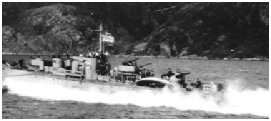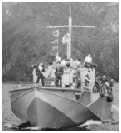H.M. Motor Torpedo Boat 718
“Something Special”


These extracts come from the following official Naval report below:
THE HISTORY OF
CLANDESTINE NAVAL OPERATIONS
June 1940 - April 1945
B O O K 1
Operations Division
Naval Staff.
January 1946
CLANDESTINE NAVAL OPERATIONS 1940-1945
An account of clandestine seaborne operations carried out by D.D.O.I.(I) on behalf of S.I.S., S.O.E., M.I.9., M.E.W. and other British and Allied authorities to enemy occupied territory in Europe and the Far East.
INTRODUCTION:
In writing an account of this nature it is harder to judge what to omit rather than what to include. The maintenance of communications with enemy-occupied Europe both by sea and air during the years 1940 to 1945 is in detail a story of absorbing interest. Each voyage, each flight, is a tale in itself, representing the culmination of a careful plan, carried out in secret on the enemy’s home ground.
Since all cannot be included, an attempt has been made to present here a general readable picture of the whole, referring now and again to individual experiences where these are of particular interest. This picture is contained in Book 1.
In the course of four years innumerable experiments were carried out with navigational aids, signalling equipment and other necessities for clandestine work. Lessons were learnt as often from “still-born” operations which were planned but never carried out as from those which were attempted. Since it is not proposed to burden the text with technicalities, the results of experience are contained in Book II of this report, together with details of operations, craft, personnel and other points of interest to the student of clandestine operations.
For purposes of simplicity the section has been referred to as “D.D.O.D.(I)” throughout the narrative, although it was in fact known as N.I.D.(C) until 1943.
It is proposed to quote only one set of figures in this part of the report, and, contrary to custom, they are given at beginning instead of the end. During the period June 1940 to April 1945 D.D.O.D.(I) was responsible for landing 1,000 agents in enemy-held territory and for embarking 3,600 agents and allied personnel. Approximately 1,150 operations were carried out involving 1,500 voyages; of these operations 75% were successful.
CHAPTER 1
NORWEGIAN OPERATIONS
Norway is reputed to have a coastline as long as the rest of Europe put together. Certainly the Germans never attempted to fortify and control it in the way that they held the “Western Wall”, and clandestine operations to Norway flourished from 1940 to 1945 in conditions which could hardly have been more favourable. But although the deeply serrated coast of Norway lends itself to work of this nature, the mountainous hinterland makes travel in Norway itself difficult for agents who do not wish their baggage or their passes to be closely examined; and the number of ferries or bridges across which travellers must pass makes control an easy matter.
At the outbreak of war, Norway possessed some 50,000 fishing boats of all sizes, ranging from the big steel-built whale-catchers of the Arctic to the little 30ft. coastal smacks. By far the greatest proportion of this large fleet were the wooden-built drifters, usually 60-70 ft. long, with semi-diesel engines and speeds between 6-10 knots. A number of such boats arrived in the Shetlands in early 1940, and a constant stream of refugees continued to arrive there throughout the next twelve months. This meant that a large number of Norwegian boats from all parts of Norway were available in the U.K. for reversing the procedure and landing parties of agents or saboteurs along the Norwegian coast.
Owing to the difficulty of travel inland, however, such agents had to be maintained from England with supplies of all sorts, and the number of operations called for was high as each group needed to be ‘serviced’ individually.
Realising the advantages in the Shetlands, S.I.S. sent a representative, Captain L.H. Mitchell (Army), to Lerwick in the summer of 1940, where ten of the best refugee craft were collected and formed into a flotilla for clandestine work, manned by Norwegian civilian crews recruited among the refugees themselves. The procedure for operations was simple enough. An agent who was recruited and trained to return to Norway would want to be sent to his own district. He would know of a local pilot for the district, if indeed he was not himself qualified in this direction. The expedition would then be built up on a ‘family’ basis and would sail from Shetlands in the most suitable ship. The ship would sail straight into the fjord nearest the agent’s home and remain there openly whilst he made enquiries on shore. If these were satisfactory the agent remained and the ship returned. This happy state of affairs continued throughout the winters of 1940/41 and 1941/42.
During the winter of 1940/41 the intelligence organisations were built up and also the S.O.E. sabotage groups in Norway. Captain Mitchell acted in Lerwick as the representative of both S.I.S. and S.O.E. In March and April 1941 S.O.E. launched an extensive series of operations from Lerwick recruiting Norwegians in Norway itself and bringing them over for short sabotage courses in the Shetlands, then returning them to their own homes with explosives and arms. The result of increased S.O.E. commitments in the Shetlands constitutes a considerable threat to S.I.S. agents passing through Lerwick.
Extracts from the Report
In May 1944 MTB 718 steamed to Lerwick from Dartmouth in three days and sailed for Norway on the fourth day to embark a party of agents on the run. She completed the operation in daylight, there being no darkness in those latitudes by that time.
A sudden spate of S.I.S. operations came forward in August and September 1944 and continued until the spring of 1945. These were dealt with by three S.C. craft, helped on four occasions by MTB 718 from D.D.O.D.(I)’s Flotilla at Dartmouth, and once by the Norwegian Whaler NARVIK.
In the winter of 1944 and the spring of 1945 clandestine operations, mainly to revictual or rescue various stations, proceeded normally. Most were done for S.I.S. by S.C. craft from Lerwick but four stand out as exceptional. These are AQUARIUS III (to rescue four agents from a small island in the southern approach to Egersund); LOLA (to land two agents on an island near Mandal); SELMA (to land two agents near Egersund) – all executed by MTB 718 – and SYHNOVE (to rescue twenty agents and families from the Lofoten Islands) – by the Norwegian Whaler NARVIK. Whether measured by the risks from the enemy or the navigational hazards of the long voyages involved, these were outstanding performances. At such distances from base special navigational aids do not function. Weather forecasts were imprecise and unreliable and no W/T contact could be maintained. Also there was the wintry sea. From Operation LOLA MTB 718 just returned in a Force 8 sea with over 3 ft. of water in the engine room and a hull so severely strained that it took over a month to repair.
... Clandestine operations came to an end when MTB 718 successfully completed Operation SELMA on 13th April 1945.
However before the gunboats finally left Aberdeen in July 1945, two further operations to Norway were carried out after VE-Day. The first of these resulted in the loss of MGB 2002, the most serious blow suffered by D.D.O.D.(I)’s flotillas. It was on 11th May 1945, three days after the end of the war in Europe, when MGB 2002, bound for Gothenburg on a special mission, struck a mine.
The conclusion of Norwegian operations followed an interesting cycle: fishing boats, then submarines, then coastal forces craft were used. Long-range ‘D’ Class Fairmiles became available at the moment when enemy controls made the use of fishing boats dangerous*. The record of the ships and crews in this area was high. Their feats of seamanship and pilotage were second to none. Their chief enemy was the weather. Norway being what it is, communications by air were on a very limited scale throughout the years of occupation, and by far the greater bulk of agents were carried to and from their areas by sea. This is particularly gratifying when it is considered that the agents’ reports dealt very largely with enemy naval and merchant shipping, and were considered of first priority importance by the Admiralty and Air Ministry. Telegrams from these agents started the chase for the BISMARCK and the SCHARNHORST; a group of agents watched and reported daily on the TIRPITZ for nearly a year before she was finally sunk; and a number of merchant convoys, submarine depot ships and other inviting targets were destroyed as a direct result of intelligence report from the Norwegian stations.
__________________________
*The dangers of the operations to Norway were evidenced by the loss, in April 1942, of two vessels sunk by enemy aircraft. This followed the loss of three further craft during the winter to storms, one of which sunk without trace with 35 passengers on board in heavy weather (The History of Clandestine Naval Operations June 1940 - April 1945 Chapter 1 page 2), and the terrible fate of MTB 345 of the 30th (Norwegian) MTB Flotilla which was captured by the Germans and whose crew of eight were executed by the Gestapo on 30th July 1943 (Dog Boats at War by Leonard C. Reynolds OBE, DSC pp41/42).
All rights reserved
| Photos |
| Dartmouth |
| Plouha |
| Norway |
| Ramming action |
| Photos ML145 |